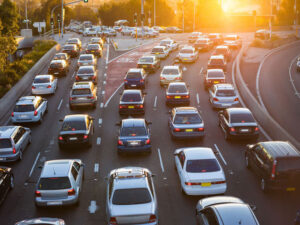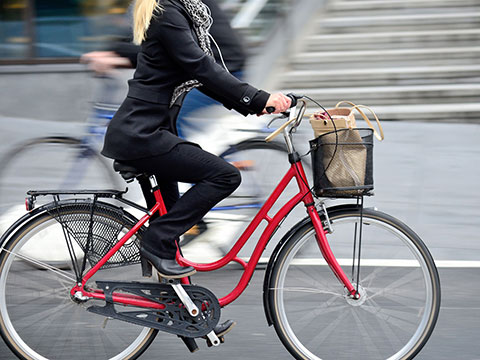The End of the Car Commute
- By Mark Saltveit
- Reading Time: 4 mins.
 We’ve been told for decades that driving your car to work is bad. It’s expensive, unhealthy, polluting, and stressful.
We’ve been told for decades that driving your car to work is bad. It’s expensive, unhealthy, polluting, and stressful.
Incentives to change this habit come and go, from mass transit systems and high occupancy vehicle lanes to carpool apps, yet year after year the vast majority of Americans continue to car commute to work alone. (In 2013, more than 75 percent of us did.) This has been true for six decades since the federal highway system was created in the mid-1950s.
Recently, ride-hailing apps (such as Uber and Lyft), bicycle commuting, and the prospect of self-driving or semi-autonomous cars have captured the media’s attention. Is the end of the era of King Car insight?
To find out, The FruitGuys Magazine spoke with a professional futurist familiar with transportation issues. Glen Hiemstra, the founder of the Seattle-based consulting firm futurist.com, has worked with the U.S. Department of Transportation, the Federal Highway Administration, and several state transportation agencies.
Hiemstra sees major changes coming, including the end of auto primacy, but they will take a while to arrive. However, the reasons for the looming decline of the car might not be the ones you imagine. New technology alone won’t pull us into the future, so don’t get your hopes up for jet packs and flying cars.
Get tips for your office
Be an office hero!
 While pressure to control climate change by limiting CO2 emissions will push us toward abandoning single-car use, demographic changes will be the major driver of this shift. Urban areas are increasingly popular, and Hiemstra thinks we’ll see some suburbs turn into separate urban villages. Increasing attention to healthy lifestyles will encourage bicycling and walking, although bad weather, hills, and infrastructure will limit this somewhat.
While pressure to control climate change by limiting CO2 emissions will push us toward abandoning single-car use, demographic changes will be the major driver of this shift. Urban areas are increasingly popular, and Hiemstra thinks we’ll see some suburbs turn into separate urban villages. Increasing attention to healthy lifestyles will encourage bicycling and walking, although bad weather, hills, and infrastructure will limit this somewhat.
The continued growth of one decades-old technology—the Internet—is another factor. “Very few info workers do not telecommute some of the time these days,” Hiemstra notes. “I expect a high percentage of work to be done remotely, whether we call it telecommuting or not. For some, 50 to 100 percent of their work, for others at least 20 percent. Ubiquitous 3-D and VR [virtual reality] cameras and screens will enhance [this shift].”
Technology Cuts Down on Trips
Getting to work is not the only thing we use cars for. Technology and city planning are helping many find alternatives to car trips. Urban design makes walking, bike riding, or transit practical for running errands and shopping, but more of us are buying online and having goods delivered. Most millennials compare prices online, and 91 percent say they buy something on their smartphones every month. Uber has made hired rides ubiquitous among young people who may have rarely taken a taxi before the new service came around. Libraries offer online research and e-books, while city governments increasingly make permits and records available online. Even doctors are beginning to schedule video appointments via computers and smartphones.
Want farm-fresh fruit?
We've got you covered.Intercity car travel has always been a grind. Plane travel has become cheap, and there’s the promise of futuristic technology—from high-speed rail to Elon Musk’s 700 mph hyperloop technology, which is on the verge of moving from the drawing board to reality—that may make it even less attractive.
As the many different uses of cars fall away, one by one, the nearly unthinkable may become practical—not having a car at all. Hiemstra predicts that “Car ownership may drop precipitously in the next generation, Gen Z, [and] not just for affordability reasons.” Hiemstra points out that young people—especially those living in cities with good public transportation options—are less and less interested in driving.
Self-Driving Cars Are a Bridge to the Future
Cars aren’t going away right this second. New technologies like the self-driving car will act as a bridge between our one-person/one-car society and a utopian post-auto future. When humans aren’t doing driving any longer, cars can become a service rather than a possession.
Hiemstra believes that autonomous cars really do deserve all of their hype. “There are a limited set of computing and navigation problems yet to be overcome to make them viable, and those will be done largely in the next 5 years—10 years, tops.”
He sees a problem, though. “The challenge for self-driving cars is the integration gap—when the cars are really ready to be fully autonomous, if we could wave a magic wand and change all the cars and trucks to autonomy at once, then we can imagine a workable system. The gap, though, is how in the world we are going to integrate autonomous vehicles with less predictable human drivers. Perhaps it will start with special lanes, zones, areas, regions, for autonomy.”
Although, as Hiemstra says, “Single-car commuting will be with us for two to three decades yet,” it does seem that the end is coming. If 30 years seems like a short time frame for the end of single-car commuting, keep in mind that it’s been dominant for only about 60 years and is massively expensive in the form of freeway maintenance, parking, and pollution. “Eventually,” Hiemstra predicts, “pleasure driving will go the way of horseback riding for pleasure—a niche activity and a public racing spectacle.”
Want farm-fresh fruit?
We've got you covered.
Mark Saltveit is the author of The Tao of Chip Kelly and Controlled Chaos: Chip Kelly’s Football Revolution. He writes regularly about health and science for the Oregon Bioscience Association; his work has also appeared in Harvard Magazine and the Oregonian newspaper.


